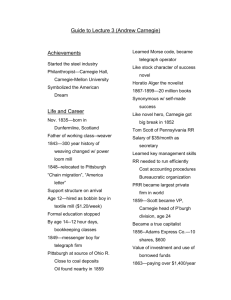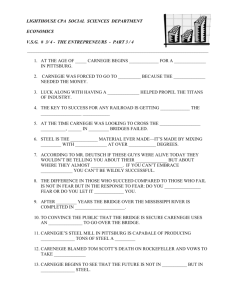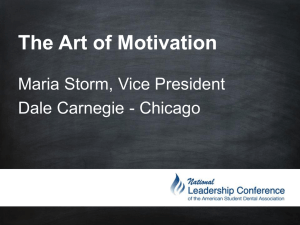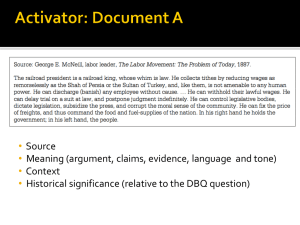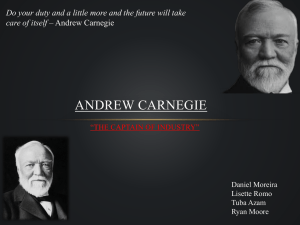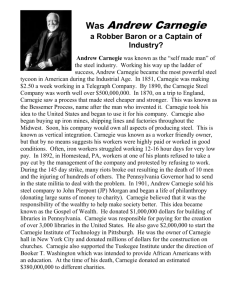Clues to W`s Miami 2013
advertisement
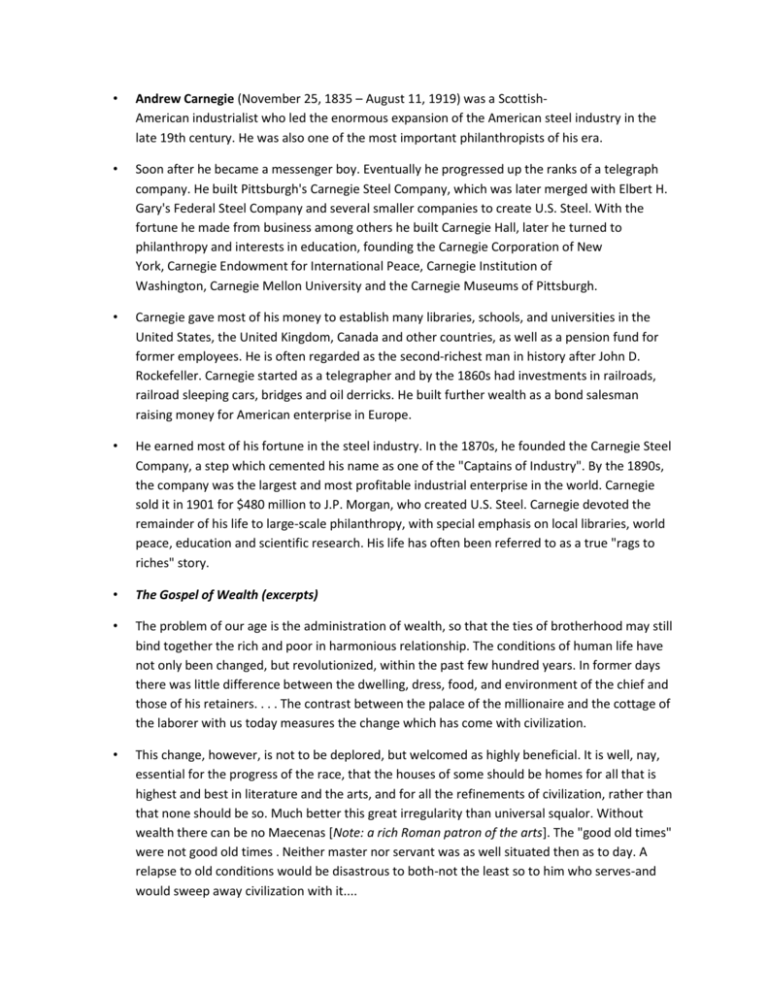
• Andrew Carnegie (November 25, 1835 – August 11, 1919) was a ScottishAmerican industrialist who led the enormous expansion of the American steel industry in the late 19th century. He was also one of the most important philanthropists of his era. • Soon after he became a messenger boy. Eventually he progressed up the ranks of a telegraph company. He built Pittsburgh's Carnegie Steel Company, which was later merged with Elbert H. Gary's Federal Steel Company and several smaller companies to create U.S. Steel. With the fortune he made from business among others he built Carnegie Hall, later he turned to philanthropy and interests in education, founding the Carnegie Corporation of New York, Carnegie Endowment for International Peace, Carnegie Institution of Washington, Carnegie Mellon University and the Carnegie Museums of Pittsburgh. • Carnegie gave most of his money to establish many libraries, schools, and universities in the United States, the United Kingdom, Canada and other countries, as well as a pension fund for former employees. He is often regarded as the second-richest man in history after John D. Rockefeller. Carnegie started as a telegrapher and by the 1860s had investments in railroads, railroad sleeping cars, bridges and oil derricks. He built further wealth as a bond salesman raising money for American enterprise in Europe. • He earned most of his fortune in the steel industry. In the 1870s, he founded the Carnegie Steel Company, a step which cemented his name as one of the "Captains of Industry". By the 1890s, the company was the largest and most profitable industrial enterprise in the world. Carnegie sold it in 1901 for $480 million to J.P. Morgan, who created U.S. Steel. Carnegie devoted the remainder of his life to large-scale philanthropy, with special emphasis on local libraries, world peace, education and scientific research. His life has often been referred to as a true "rags to riches" story. • The Gospel of Wealth (excerpts) • The problem of our age is the administration of wealth, so that the ties of brotherhood may still bind together the rich and poor in harmonious relationship. The conditions of human life have not only been changed, but revolutionized, within the past few hundred years. In former days there was little difference between the dwelling, dress, food, and environment of the chief and those of his retainers. . . . The contrast between the palace of the millionaire and the cottage of the laborer with us today measures the change which has come with civilization. • This change, however, is not to be deplored, but welcomed as highly beneficial. It is well, nay, essential for the progress of the race, that the houses of some should be homes for all that is highest and best in literature and the arts, and for all the refinements of civilization, rather than that none should be so. Much better this great irregularity than universal squalor. Without wealth there can be no Maecenas [Note: a rich Roman patron of the arts]. The "good old times" were not good old times . Neither master nor servant was as well situated then as to day. A relapse to old conditions would be disastrous to both-not the least so to him who serves-and would sweep away civilization with it.... • Time Zones!!! Chicago's famous Grand Pacific Hotel, then on the site of the present Continental Bank Building, was the location of the General Time Convention of 1883 which, on October 11 of that year, adopted the current Standard Time System in the United States. The Conventions was called by the nation's railroads. Delegates were asked to develop a better and more uniform time system to govern railroad operations. Previously, time had been determined by the position of the sun, with high noon as the only existing standard of local time. More than 100 different local times resulted from this method. The new plan, proposed by William F Allen, Convention Secretary, established four equal time zones across the country, each one hour ahead of the zone to it's west. All railroad clocks in each zone were to be synchronized to strike the hour simultaneously. The Standard Time System was inaugurated on November 18, 1883. ON that Sunday, known as the ""Day of Two Noons," the Allegheny Observatory at the University of Pittsburgh transmitted a telegraph signal when it was exactly noon on the 90th meridian. Railroad clocks throughout the United States were then reset on the hour according to time zone. Although implemented by the railroads, the Federal Government, states and cities began to use the system almost immediately. On March 19, 1918, Congress formally acknowledged the plan by passing the Standard Time Act. Lewis Payne: • Using the pseudonym "Lewis Payne", Lewis Thornton Powell was the youngest and the most stoic of the Lincoln conspirators associated with John Wilkes Booth and the assassination attempts of April 14, 1865. A former member of John Mosby's Confederate rangers, Powell was given the task of assassinating Secretary of State William Seward, who was at his home near the White House recuperating from a recent carriage accident. Miraculously, Seward survived Powell's knife attack but was facially scarred for the rest of his life. Powell was arrested a few days later and confined in the Old Capitol Prison. He was tried, found guilty, and sentenced to hang with the three (3) other conspirators on July 7, 1865.

